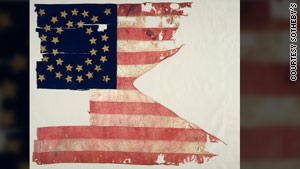
New York (CNN) -- A flag that accompanied Lt. Col. George Armstrong Custer and his 7th Cavalry into their final battle 134 years ago will be put up for auction, the auction house that will handle the sale said Friday.
Custer led more than 200 other other soldiers into battle against thousands of Lakota and Northern Cheyenne warriors on June 25, 1876, at the Little Bighorn River in what is now Montana. None of the U.S. soldiers survived the battle.
The flag that will be sold in October is tattered and fragile, measures 27½ by 33 inches and may be stained with blood. It was found three days after the Battle of Little Bighorn -- or the Battle of Greasy Grass Creek, as the victors called it -- beneath the body of one of Custer's men killed in the battle.
Sgt. Ferdinand Culbertson, a member of the burial detail assigned to retrieve the remains of the 7th Cavalry, found the Cavalry guidon, or swallow-tail flag, that was used by cavalry companies. The design reduced wind drag as the soldiers advanced.
"It's not a piece of decoration," said Sotheby's vice chairman, David Redden. "It's a sacred relic. People died for this flag. This flag is really important as it symbolizes one of the great and mythological battles in American history."
Another flag from the battle site was found months later in an Indian village seized by U.S. troops and is now owned by the National Park Service, but Redden said it is in very poor condition.
Custer's last battle was part of the United States government's 1876-77 campaign to retake the Black Hills region, ceded in perpetuity by an 1868 treaty to the Lakota. But when gold was discovered in the area, the army was sent to push the aboriginal Americans to a reservation set up for them.
The 7th Cavalry surprised the Lakota and Cheyenne, camped on the river banks, but Custer vastly underestimated their number and was crushed.
Sitting Bull and Crazy Horse were among the Lakota leaders who took part in the battle.
The Detroit Institute for the Arts acquired the flag in 1895 for $54 but has decided to part with it and use the proceeds for future art acquisitions.
The Institute's director, Graham Beal, says the flag won't be missed as it was often on loan to other institutions, most recently at the Little Bighorn Battlefield National Monument in Montana.
"The sale will help with future acquisitions," said Beal. "With the proceeds we will get art for the collection. Even though we are in Detroit, we have one of the great universal collections including Baroque, African and early modern collections. We are right up there with Chicago, Cleveland and Philadelphia.
Author Nathaniel Philbrick, whose book "The Last Stand: Custer, Sitting Bull and the Battle of the Little Big Horn" was released in May, said the significance of shabby flag is enormous.
"It's not only symbolic, but it's also just a terrific artifact," he said. "It's pretty intact and given what it went through, it's amazing."
John Doerner, chief historian at the Little Bighorn Battlefield National Monument, said he believes the flag is stained with the blood of a fallen soldier and that the banner belongs to the American people.
"It was an act of courage and bravery," said Doerner, a 20-year veteran of the National Parks Service.
"To lose the colors was really something that a soldier would give their lives [to prevent]," he said.
Doerner is helping oversee events for the battle's anniversary this weekend at the national monument, where visitors will hear symposiums and view re-enactments. He is hopeful that a benefactor will purchase the flag and loan it to a national museum.
Redden said expectations are good that the Custer flag sale price might exceed Sotheby's $2 million to $5 million estimate, but the hope is that the sale will come close to the $12.3 million paid for a Revolutionary Battle flag in 2006, a record for any military relic at auction.



test